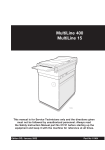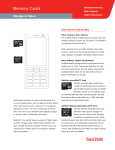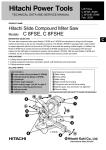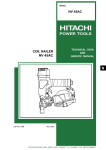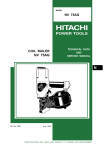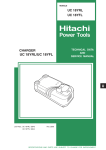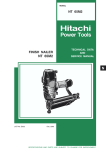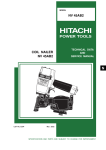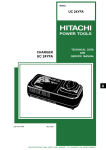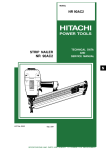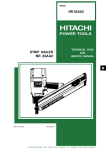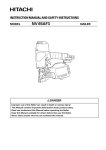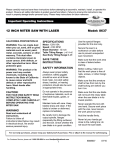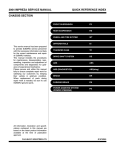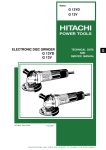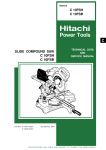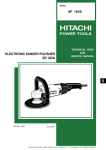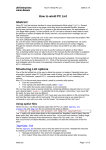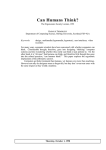Download finish nailer nt 65ma
Transcript
MODEL NT 65MA POWER TOOLS FINISH NAILER NT 65MA TECHNICAL DATA AND SERVICE MANUAL N LIST No. 1093 Dec. 1999 SPECIFICATIONS AND PARTS ARE SUBJECT TO CHANGE FOR IMPROVEMENT REMARK: Throughout this TECHNICAL DATA AND SERVICE MANUAL, a symbol(s) is(are) used in the place of company name(s) and model name(s) of our competitor(s). The symbol(s) utilized here is(are) as follows: Competitors Symbols Utilized Company Name Model Name T SENCO SFN40 P BOSTITCH N60FN Notice for use Specifications and parts are subject to change for improvement. Refer to Hitachi Power Tool Technical News for further information. CONTENTS [ Business Section ] Page 1. PRODUCT NAME •••••••••••••••••••••••••••••••••••••••••••••••••••••••••••••••••••••••••••••••••••••••••••••••••••••••••••••••••••••• 2. MARKETING OBJECTIVE 3. APPLICATIONS 1 • • • • • • • • • • • • • • • • • • • • • • • • • • • • • • • • • • • • • • • • • • • • • • • • • • • • • • • • • • • • • • • • • • • • • • • • • • • • • • • • • • • • • • • • • • • • • • • • • • • • • • • • • 1 • • • • • • • • • • • • • • • • • • • • • • • • • • • • • • • • • • • • • • • • • • • • • • • • • • • • • • • • • • • • • • • • • • • • • • • • • • • • • • • • • • • • • • • • • • • • • • • • • • • • • • • • • • • • • • • • • • • • • • • • • 1 4. SELLING POINTS • • • • • • • • • • • • • • • • • • • • • • • • • • • • • • • • • • • • • • • • • • • • • • • • • • • • • • • • • • • • • • • • • • • • • • • • • • • • • • • • • • • • • • • • • • • • • • • • • • • • • • • • • • • • • • • • • • • • • • 5. SPECIFICATIONS 5-1. Specifications 5-2. Nail Selection 5-3. Examples of Nail Use 5-4. Nail Driving Force 1 • • • • • • • • • • • • • • • • • • • • • • • • • • • • • • • • • • • • • • • • • • • • • • • • • • • • • • • • • • • • • • • • • • • • • • • • • • • • • • • • • • • • • • • • • • • • • • • • • • • • • • • • • • • • • • • • • • • • • • 2 ••••••••••••••••••••••••••••••••••••••••••••••••••••••••••••••••••••••••••••••••••••••••••••••••••••••••••••••••••••••• 2 ••••••••••••••••••••••••••••••••••••••••••••••••••••••••••••••••••••••••••••••••••••••••••••••••••••••••••••••••••••••• 3 •••••••••••••••••••••••••••••••••••••••••••••••••••••••••••••••••••••••••••••••••••••••••••••••••••••••••••• 3 ••••••••••••••••••••••••••••••••••••••••••••••••••••••••••••••••••••••••••••••••••••••••••••••••••••••••••••••••• 4 6. COMPARISONS WITH SIMILAR PRODUCTS 7. PRECAUTIONS IN SALES PROMOTION 7-1. Instruction Manual 7-2. Warning Label 7-3. Related Laws and Regulations • • • • • • • • • • • • • • • • • • • • • • • • • • • • • • • • • • • • • • • • • • • • • • • • • • • • • • • • • • • • • • • • • • • • • • • • • • • 5 • • • • • • • • • • • • • • • • • • • • • • • • • • • • • • • • • • • • • • • • • • • • • • • • • • • • • • • • • • • • • • • • • • • • • • • • • • • • • • • • • • 6 •••••••••••••••••••••••••••••••••••••••••••••••••••••••••••••••••••••••••••••••••••••••••••••••••••••••••••••••• •••••••••••••••••••••••••••••••••••••••••••••••••••••••••••••••••••••••••••••••••••••••••••••••••••••••••••••••••••••• •••••••••••••••••••••••••••••••••••••••••••••••••••••••••••••••••••••••••••••••••••••••••••••• 8. MECHANISM AND OPERATION PRINCIPLE 8-1. Mechanism 8-2. Valve Bushing (B) and Plunger 8-3. Interchangeability of Parts 8-4. Operation Principle 6 6 7 • • • • • • • • • • • • • • • • • • • • • • • • • • • • • • • • • • • • • • • • • • • • • • • • • • • • • • • • • • • • • • • • • • • • • • • • • • • • • 8 • • • • • • • • • • • • • • • • • • • • • • • • • • • • • • • • • • • • • • • • • • • • • • • • • • • • • • • • • • • • • • • • • • • • • • • • • • • • • • • • • • • • • • • • • • • • • • • • • • • • • • • • • • • • • • • • • • • • • • • • • • 8 •••••••••••••••••••••••••••••••••••••••••••••••••••••••••••••••••••••••••••••••••••••••••••••• 10 • • • • • • • • • • • • • • • • • • • • • • • • • • • • • • • • • • • • • • • • • • • • • • • • • • • • • • • • • • • • • • • • • • • • • • • • • • • • • • • • • • • • • • • • • • • • • • • • • • • • • 10 ••••••••••••••••••••••••••••••••••••••••••••••••••••••••••••••••••••••••••••••••••••••••••••••••••••••••••••••• 11 [ Service Section ] 9. TROUBLESHOOTING GUIDE 9-1. Troubleshooting and Correction 9-2. Regrinding the Driver Blade 9-3. Possible Cause and Correction of Air Leakage • • • • • • • • • • • • • • • • • • • • • • • • • • • • • • • • • • • • • • • • • • • • • • • • • • • • • • • • • • • • • • • • • • • • • • • • • • • • • • • • • • • • • • • • • • • • • • • • • • • • 13 • • • • • • • • • • • • • • • • • • • • • • • • • • • • • • • • • • • • • • • • • • • • • • • • • • • • • • • • • • • • • • • • • • • • • • • • • • • • • • • • • • • • • • • • • • • • • 13 ••••••••••••••••••••••••••••••••••••••••••••••••••••••••••••••••••••••••••••••••••••••••••••••••••• 17 • • • • • • • • • • • • • • • • • • • • • • • • • • • • • • • • • • • • • • • • • • • • • • • • • • • • • • • • • • • • • • • • • • • • • • • 10. DISASSEMBLY AND REASSEMBLY 10-1. General Precautions in Disassembly and Reassembly 10-2. Disassembly and Reassembly of the Output Section 10-3. Disassembly and Reassembly of the Control Valve Section 10-4. Disassembly and Reassembly of the Driving Section 10-5. Disassembly and Reassembly of the Cap and the Magazine Section 18 ••••••••••••••••••••••••••••••••••••••••••••••••••••••••••••••••••••••••••••••••••••••• 20 •••••••••••••••••••••••••••••••••••••••••••••••••••••••••• 20 • • • • • • • • • • • • • • • • • • • • • • • • • • • • • • • • • • • • • • • • • • • • • • • • • • • • • • • • • • • • • 21 • • • • • • • • • • • • • • • • • • • • • • • • • • • • • • • • • • • • • • • • • • • • • • • • • • • 24 • • • • • • • • • • • • • • • • • • • • • • • • • • • • • • • • • • • • • • • • • • • • • • • • • • • • • • • • • • • • 27 • • • • • • • • • • • • • • • • • • • • • • • • • • • • • • • • • • • • • 28 •••••••••••••••••••••••••••••••••••••••••••••••••• 30 11. INSPECTION AND CONFIRMATION AFTER REASSEMBLY 12. STANDARD REPAIR TIME (UNIT) SCHEDULES • • • • • • • • • • • • • • • • • • • • • • • • • • • • • • • • • • • • • • • • • • • • • • • • • • • • • • • • • • • • • • • • • • • • • 31 [ Appendix ] Assembly Diagram for NT 65MA ••••••••••••••••••••••••••••••••••••••••••••••••••••••••••••••••••••••••••••••••••••••••••••••••••• 32 1. PRODUCT NAME Hitachi Finish Nailer, Model NT 65MA 2. MARKETING OBJECTIVE The Model NT 65MA finish nailer (angle type 15 Ga. x 65 mm (2-1/2")) is an upgraded version of the current Model NT 65AA, equipped with a blow nozzle for cleaning chips while nail driving. The Model NT 65MA is the lightest (2.0 kg (4.4 lbs.)) and most powerful finish nailer in this class. We are confident that your sales will increase with the new Model NT 65MA. 3. APPLICATIONS For manufactured housing, on-site and mobile home construction: Mounting of light and heavy trim Installation of molding, paneling and stairways Assembling of window and door casings For cabinet-making, furniture-making and woodworking 4. SELLING POINTS Capable of cleaning chips and sawdust of course it drives nails thanks to the blow nozzle Lightweight and powerful Equipped with a racket grip For comfort Exhaust direction easily changeable Simple drivedepth adjusting mechanism Easy-to-use clogged nail release mechanism --- 1 --- 5. SPECIFICATIONS 5-1. Specifications Model NT 65MA Driving system Reciprocating piston type Operating pressure 5 --- 8.5 kgf/cm2 (70 --- 120 psi, 4.9 --- 8.3 bar) (Gauge pressure) Driving speed 3 pcs./sec Weight 2.0 kg (4.4 lbs.) Dimensions (Length x Height x Width) 344 mm x 305 mm x 82 mm (13-17/32" x 12" x 3-7/32") Nail feed system Ribbon spring Nail capacity 100 nails Air consumption 1.20 ltr/cycle at 7 kgf/cm2 (0.042 ft3/cycle at 100 psi) (1.20 ltr/cycle at 6.9 bar) Air inlet 3/8 NPT thread Packaging Corrugated cardboard box (Sleeve type) Package dimensions (Length x Height x Width) 430 mm x 380 mm x 113 mm (16-15/16" x 14-15/32" x 4-7/16") Standard accessories Eye protector (Code No. 875769) Hex. bar wrench for M5 screw (Code No. 944458) Hex. bar wrench for M6 screw (Code No. 944459) Case (Code No. 881775) Nose cap (A) (Code No. 881751) • • • • • • • • • • • • • • • • • • • • • • • • • • • • • • • • • • • • • • • • • • • • • • • • • • • • • • • • • • • • • • • • • • • • • • • • • • • • • • • • • • • • • • • • • • • • • • • • • • • • • • • • • • • • • • • • • • • • • • • • • • • • • • • • • • • • • • • • • • • • • • • • • • • • • • • • • • • • • • • • • • • • • • • • • • • • • • • • • • • • • • • • • • • • • • • • • • • • • • • • • • • • • • • • • • • • • • • • • • • • • • • • • • • • • • • • • • • • • • • • • • • • • • • • • • • • • • • • • • • • • • • • • • • • • • • • • • • • • • • • • • • • • • • • • • • • • • • • • • • • • • • • • • • • • Optional accessories Sequential trip mechanism kit (Single shot) Pneumatic tool lubricant (1 oz oil feeder) Pneumatic tool lubricant (4 oz oil feeder) Pneumatic tool lubricant (1 quart can) --- 2 --- (Code No. 880414) (Code No. 877153) (Code No. 872042) (Code No. 876212) 1 1 1 1 1 5-2. Nail Selection The Model NT 65MA utilizes small-head, T-shaped nails (finish nails) collated by tapes. Applicable nails are shown below. CAUTION: Ensure that nails are as specified in Fig. 1. Other nails will cause clogging of nails and subsequent damage to the nailer. 15-gauge finish nail (collating angle 34˚) Max. 0.12" (3.0 mm) Min. 0.072" (1.8 mm) 0.045" (1.1 mm) 0.095" (2.4 mm) 2 -1/2" (65 mm) 0.045" (1.1 mm) 0.12" 1 -1/4" (32 mm) (3.0 mm) 0.095" (2.4 mm) 0.072" (1.8 mm) 34˚ Tapes Fig. 1 Dimensions of nails 5-3. Examples of Nail Use B: Base molding A: Crown molding Nail Ceiling Examples of uses for the nails shown in 5-2 for Wall installing finish materials, or molding as shown in Base molding Fig. 2. Typical mounting methods are shown in circles A and B. Nail Crown molding Nail A Floor Wall Bed Corner guard Cove Crown Casing Lattice Rabbeted stool Batten Flat stool Base cap Chair rail B Ply cap Base molding Base shoe Wainscot Fig. 2 Examples of molding --- 3 --- 5-4. Nail Driving Force Fig. 3 shows by type of wood and nail the nailer output energy provided by the supply pressure and the nailing energy required for driving the nail flush. Air pressure which exceeds the intersecting point between the nailer output energy and the required nailing energy required for driving the nail allows the nail to be fully driven. For example, when driving a 1.8 mm dia. by 65 mm (5/64" by 2-1/2") nail into six sheets of 12 mm plywood (72 mm thick) with the Model NT 65MA, a pressure of about 6.3 bar (6.4 kgf/cm2, 91 psi) allows the nailer to drive the nail flush with the surface. A pressure beyond this causes the nail head to be driven below the wood surface. Fig. 3 should be used as reference data because those values vary depending on the type of wood, moisture content, and grain of wood. Required nailing energy Nailer output energy (J) (ft-lb) (kgf•cm)) (J) (ft-lb) (kgf•cm)) 60 60 80 80 Plywood (12 mm thick) x 6 800 NT65MA 800 NT65AA 60 60 600 O 600 40 40 40 40 400 400 P 20 20 20 0 200 100 50 200 (mm2) 150 0.15 0.10 0.20 0.25 20 0 0.30 4 5 4 5 6 6 7 8 7 8 1.8 mm x 65 mm (0.072 x 2-1/2") 1.8 mm x 57 mm (0.072 x 2-1/4") 1.8 mm x 50 mm (0.072 x 2") 1.8 mm x 45 mm (0.072 x 1-3/4") 1.8 mm x 38 mm (0.072 x 1-1/2") 1.8 mm x 32 mm (0.072 x 1-1/4") (in2) Size of nail 200 60 Nail : d x L (mm x mm) L 70 80 90 100 110 8.3 (bar) 8.5 (kgf/cm2) 120 (psi) Air pressure setting to drive nail flush with NT 65MA d Fig. 3 Required nailing energy and nailer output energy --- 4 --- 6. COMPARISONS WITH SIMILAR PRODUCTS HITACHI Maker NT 65MA Model name Operating pressure NT 65AA 5 --- 8.5 kgf/cm2 (70 --- 120 psi) 2.0 kg (4.4 lbs.) Weight Dimensions (L x H x W) Air consumption at 7 kgf/cm2 (100 psi) 344 mm x 305 mm x 82 mm (13-17/32" x 12" x 3-7/32") 1.20 ltr/cycle Blow nozzle P 5 --- 8.5 kgf/cm2 (70 --- 120 psi) 5 --- 7 kgf/cm2 (70 --- 100 psi) 2.17 kg (4.7 lbs.) 1.95 kg (4.4 lbs.) 330 mm x 286 mm x 89 mm 359 mm x 276 mm x 76 mm (13" x 11-1/4" x 3-1/2") (14-1/8" x 10-7/8" x 3") 1.25 ltr/cycle 3 1.31 ltr/cycle (0.042 ft /cycle) (0.044 ft /cycle) (0.046 ft3/cycle) 100 pcs. 100 pcs. 100 pcs. Rear loading type Angle: 34˚ Rear loading type Angle: 34˚ Rear loading type Angle: 26˚ None None Nail capacity Magazine type 1.9 kg (4.2 lbs.) T None Provided 3 Direction change of exhaust air Easily changeable 360˚ by turning by hand Only 4 directions by 90˚each by replacing the piece Changeable 360˚, but requires a hex. bar wrench Clogged nail release method Single-touch operation by hand Single-touch operation by hand Prying out with a flat-blade screwdriver With an easy-to-adjust scale No scale No scale Racket grip (Easy to grip) Hook and loop tape type (Slippery) Rubber (Unpleasant touch) 34˚ 34˚ 26˚ Driving depth adjustment mechanism Adjusting scale Handle grip Collating angle Applicable nails Dia. Length 2.4 mm --- 3.0 mm (#15) (.095" --- .12") 32 mm --- 65 mm (1-1/4" --- 2-1/2") --- 5 --- 2.4 mm --- 3.0 mm (#15) 2.4 mm --- 3.0 mm (#15) (.095" --- .12") (.095" --- .12") 32 mm --- 65 mm (1-1/4" --- 2-1/2") 32 mm --- 65 mm (1-1/4" --- 2-1/2") 7. PRECAUTIONS IN SALES PROMOTION In the interest of promoting the safest and most efficient use of the Model NT 65 MA Nailer by all of our customers, it is very important that at the time of sale the salesperson carefully ensures that the buyer seriously recognizes the importance of the contents of the Instruction Manual, and fully understands the meaning of the precautions listed on the Warning Label attached to each tool. The standard Model NT65MA is intended for continuous nail driving. (Note that the Model NT65MA is single-shot type in some areas.) Salespersons must advise the customers that the sequential trip mechanism kit, which can change the Model NT 65MA into a single-shot type, is available as an option (and change the Model NT 65MA when there is a customer’s need). Refer to the leaflet attached to the Instruction Manual. 7-1. Instruction Manual Although every effort is made in each step of the design, manufacture, and inspection to provide protection against safety hazards, the dangers inherent in the use of any pneumatic tool cannot be completely eliminated. Accordingly, general precautions and suggestions for use of pneumatic tools, and specific precautions and suggestions for the use of the pneumatic nailer are listed in the Instruction Manual to enhance the safe, efficient use of the tool by the customer. Salespersons must be thoroughly familiar with the contents of the Instruction Manual to be able to offer appropriate guidance to the customers during sales promotion. 7-2. Warning Label Each Model NT 65MA unit is provided with a Warning Label (illustrated below) which lists basic safety precautions in its use. Carefully ensure that customers fully understand and follow these precautions before using the tool. READ INSTRUCTION MANUAL before use. Failure to follow instructions WILL RESULT IN SERIOUS INJURY. Operator and others in work area MUST WEAR ANSI-REQUIRED EYE PROTECTOR. NEVER USE BOTTLED GASES. Use regulated air only. DO NOT EXCEED 120 psi/8.3 bar. NEVER CARRY WITH FINGER ON TRIGGER. DISCONNECT AIR before servicing, unjamming or when not in use. --- 6 --- 7-3. Related Laws and Regulations As nailers and staplers are designed to instantaneously drive nails and staples, there is an ever-present danger of misfiring and subsequent possible serious injury. Accordingly, close attention in handling is absolutely necessary at all times. Carefully ensure that the customer is fully aware of the precautions listed in the Instruction Manual provided with each unit. While there are no specific safety regulations, there are related items in various general safety regulations with which the salespersons should be familiar in order to properly advise the customer. Please check your national and/or local regulations for applicable items. Some applicable items are outlined below. The U.S.A.: OSHA 1926.102 Eye and face protection 1962.302 Power-operated hand tools ANSI SNT-101-1993 Portable, Compressed-Air-Actuated, Fastener Driving Tools-Safety Requirements for --- 7 --- 8. MECHANISM AND OPERATION PRINCIPLE 8-1. Mechanism Most of the parts of the output section have been newly designed for the addition of the blow nozzle function, though its basic construction is the same as that of the Model NT 65AA. Primary differences from the Model NT 65AA are described below. Output section • • • • • • • • • • • • • The exhaust cover, nose, valve bushing, plunger, valve packing, knob and spring have been newly designed for the blow nozzle function. The top cover and plate are common to the Models NR 90AC and NV 65AH. --- 8 --- Nose [6] Valve Packing [19] O-Ring (1AP-3) [22] Valve Piston [66] O-Ring (S3) [23] Plunger Spring [68] Valve Bushing (B) [62] Accumulator Spring [20] Plunger [21] O-Ring (S-10) [24] Plunger [70] Valve Bushing [25] Valve Bushing (A) [71] Cross-sectional view of blow nozzle Control valve section Body Ass’y [34] Top Cover [3] Exhaust Cover [5] Exhaust Vent Knob [26] Output section Exhaust Valve Rubber (A) [8] Cap (A) [53] Magazine Cover [72] Control valve section Head Valve Rubber (A) [13] Accumulator Trigger (A) [57] Cylinder [15] Piston Bumper [30] Nail Stopper [82] Driving section Guide Plate (B) [35] Nail Rail [79] Magazine [83] Lock Lever [38] Magazine section Guide Plate (A) [37] Pushing Lever (A) [46] Nail Feeder (B) [78] Nail Feeder (A) [76] --- 9 --- Fig. 4 Construction 8-2. Valve Bushing (B) and Plunger Among the newly designed parts, the difference between the new design and the current one are shown below, for valve bushing (B) and the plunger because their shapes are so similar. Newly designed part Current part (NV 50AE, NV 50AG) 4 0.3 Color: Aluminum (Silver) O-Ring groove (2 pcs.) Hole (Dia. 0.2 mm) Plunger Groove Overall length: 33.9 mm Color : Black O-Ring groove (1 pc.) Overall length: 38 mm Valve bushing (B) No notches. Notches are added (4 pcs.). (Width: 4 mm, depth: 0.3 mm) 8-3. Interchangeability of Parts The parts which are not interchangeable with those of the Model NT 65AA are given in the table below. (The numbers in [Bold] indicate the item numbers in the Model NT 65MA Parts List.) Parts [1] Hex. Socket Hd. Bolt M6 x 16 Common to the Models NR 90AC and NV 65AH (for Top Cover [3]) [2] Plate Common to the Models NR 90AC and NV 65AH [3] Top Cover Common to the Models NR 90AC and NV 65AH [5] Exhaust Cover Newly designed [6] Nose Newly designed [18] Caution Plate Newly designed [19] Valve Packing Newly designed [20] Spring Newly designed [21] Plunger Newly designed [22] O-Ring (1AP-3) Common to the Model NT 50AD [23] O-Ring (S3) Newly designed [24] O-Ring (S-10) Newly designed [25] Valve Bushing Newly designed [26] Knob Newly designed --- 10 --- NT 65MA NT 65AA 8-4. Operation Principle Exhaust Valve Rubber (A) [8] (1) Before nailing: (Fig. 5, Fig. 6) Exhaust vent 1) When compressed air is fed to the main body, it fills the Accumulator ( Head valve chamber Head Valve Spring [9] ). 2) At the same time, the compressed air flows into the Air passage Head Valve[11] valve piston lower chamber of the control valve Control valve section Accumulator section and forces the Valve Piston [66] upward. Also, the compressed air is fed through the air Piston [29] supply vent and air passage to the head valve Cylinder [15] chamber. As a result, the Head Valve Spring [9] is Cylinder hole pushed down together to seal the Head Valve [11] Trigger (A) [57] Return air chamber and Cylinder [15]. (2) When nailing: (Fig. 5, Fig. 6) 1) When Pushing Lever (A) [46] and Trigger (A) [57] are operated together and the Plunger [70] is pushed upward, the compressed air in the valve Pushing Lever (A) [46] Nail piston lower chamber is discharged from the bottom Fig. 5 of the Plunger [70]. As a result, the compressed air in the accumulator ( ) pushes down the Valve Piston [66], blocking the air supply vent and opening the exhaust valve. 2) When the exhaust valve opens, the compressed air in the feed valve chamber is discharged into the To the head valve chamber atmosphere through the air passage. 3) When the air pressure applied on the bottom surface of the Head Valve [11] overcomes the strength of the Air passage Air supply vent Accumulator Head Valve Spring [9], the Head Valve [11] is pushed upward. At this time, the Head Valve [11] Exhaust valve seals with Exhaust Valve Rubber (A) [8], blocking the passage to the exhaust vent. 4) When the Head Valve [11] goes up, the compressed Valve Piston [66] air in the accumulator flows rapidly into the Cylinder [15], forcing the Piston [29] downward to strike the nail. When the Piston [29] passes the cylinder hole, the compressed air flows into the return air chamber and is accumulated there. --- 11 --- Valve piston lower chamber Plunger [70] Fig. 6 Control valve section (3) During return: (Fig. 7, Fig. 8) Exhaust Valve Rubber (A) [8] 1) When either Pushing Lever (A) [46] or Trigger (A) Head valve chamber Exhaust vent [57] is released, the Plunger [70] goes down and the compressed air in the accumulator flows into the Accumulator Air passage Head Valve [11] valve piston lower chamber. 2) As the air pressure in the valve piston lower chamber Control valve section Cylinder [15] increases to overcome the air pressure applied on Return air chamber the upper portion of the Valve Piston [66], the Valve Piston [66] is forced upward. When this occurs, the Piston [29] exhaust valve is closed and the air supply vent is Trigger (A) [57] opened. Piston Bumper [30] 3) When the air supply vent opens, the compressed air in the accumulator ( ) passes through the air passage and flows into the head valve chamber to Driver blade push down the Head Valve [11]. As a result, the Head Valve [11] and Cylinder [15] are sealed and, Pushing Lever (A) [46] at the same time, the Head Valve [11] and Exhaust Valve Rubber (A) [8] are released to open the Fig. 7 exhaust vent. 4) The compressed air at the upper portion of the Piston [29] is discharged into the atmosphere through the exhaust vent. In this way, the air pressure at the upper portion of the Piston [29] is To the head valve chamber reduced, and the greater pressure of the air accumulated in the return air chamber pushes the Piston [29] upward. Air supply vent 5) If the air pressure at the lower portion of the Piston Accumulator Air passage [29] is higher than that of the atmosphere after the Piston [29] has fully returned, the excess air pressure is discharged into the atmosphere through the clearance between the Piston Bumper [30] and the driver blade. Exhaust valve Valve Piston [66] Valve piston lower chamber Plunger [70] Fig. 8 Control valve section --- 12 --- 9. TROUBLESHOOTING GUIDE 9-1. Troubleshooting and Correction Problem 1) Nails cannot be driven. Possible cause (*: most-common cause) < Nails > The magazine is not loaded with specified genuine nails. The magazine is loaded with abnormal nails (bent nails, abnormal collation, other). <Magazine> Nail feeder abnormal (burrs, deformed, damaged). Ribbon spring abnormal (fatigued, damaged). Magazine groove too wide or too narrow. Nail rail groove width too wide or too narrow. Inspection methods Check if the magazine is normally loaded with specified genuine nails. Remedy Use specified genuine nails. Remove the abnormal nails and load the magazine with normal nails. Check the nail feeding section for abnormal conditions (burrs, fatigued, deformed, damaged). Correct the burred or deformed portion. Replace the defective part. Replace the defective part. Check if they move smoothly after loading nails and check if the nail feeder operates smoothly. Replace the defective part. Replace the defective part. --- 13 --- Nail groove in the blade guide abnormal (burrs). Replace the defective part. Magazine cover abnormal (deformed, damaged). * Adhesive fragments and wood chips are on the magazine, nail feeder or nail rail. <Output section: piston, driver blade, etc.> Air pressure too low. * Piston ring worn. Nail rail Oil After removing the adhesive fragments and wood chips, apply oil to the nail rail. Keep the nail feeder in the back position after pulling it backward and release the lock lever for idle driving. Then, check if the driver blade and guide plate (A) have returned. * Piston bumper abnormal. Adjust for 5 to 8.5 kgf/cm2 (4.9 --- 8.3 bar, 70 --- 120 psi). Replace the piston ring. Replace the piston bumper. The O-ring of the cylinder is abnormal (dislocated, deformed, damaged). Reassemble or replace. Driver blade abnormal (deformed, burrs, damaged). Bumper sheet abnormal (square hole worn, damaged). Cylinder's internal surface abnormal (deposits of dirt, worn). Touch up or replace. Replace the part. Check if nails can be driven at 5 kgf/cm2 (4.9 bar, 70 psi). After removing the dirt, apply oil or replace. Problem 1) Nails cannot be driven. Possible cause (*: most-common cause) Head valve sliding surface abnormal (uneven, damaged, oiling needed). Inspection methods While idle driving, check if the driving operation takes place. Head valve rubber abnormal (torn, damaged). While idle driving, check if the driver blade is held down. 2) Nails bent while being driven. Replace the part. --- 14 --- After making idle driving, check if the driver blade keeps the down position. Replace the part. O-ring worn or oiling needed. Disassemble the control valve and check the O-ring. Apply grease. For short nails, the adjuster is raised too high. Check if the adjuster is raised too high. Turn the adjuster for lower (lower the pressure). Nails are not fully fed into the ejecting port. See item 1). See item 1). Unspecified nails used. See item 1). See item 1). Check if the driver blade tip is abnormally worn. Replace the part. Regrind (see 9-2, "Regrinding the Driver Blade"). The material being driven into is very hard. Check if a nail is bent even when driven into soft wood. Unusable because the tool is not designed for such usage. The adjuster is improperly adjusted. Turn the adjuster to the lowest position, then drive. Adjust the adjuster for the proper position. * Driver blade worn. 3) The driven nail is driven into the material but the head is raised above the surface. Replace the part. Apply grease. Replace the part. Abnormal spring in head valve (fatigued, damaged). <Control valve section> Abnormal plunger, valve piston, valve bushing (A) or valve bushing (B) (burrs, damaged). Remedy Air pressure too low. The material being driven into is very hard. * Driver blade worn. Adjust for 5 to 8.5 kgf/cm2 (4.9 --- 8.3 bar, 70 --- 120 psi). Drive the nail into soft wood and check if the head is raised or not. Unusable because the tool is not designed for such usage. Check if the driver blade tip is worn. Replace the part. Regrind (see 9-2, "Regrinding the Driver Blade"). Problem Possible cause (*: most-common cause) 3) The driven nail * Piston ring is abnormal (worn, damaged). is driven into the material but the head is Cylinder’s internal surface abnormal (worn, raised above rough). the surface. --- 15 --- 4) Nails clog the mechanism. Inspection methods Disassemble the output section and check the piston ring and the internal surface of the cylinder for abnormal condition. Remedy Replace the defective part. Replace the defective part. Exhaust valve rubber abnormal (worn, damaged, flaws on seal surface). Disassemble and check the exhaust valve rubber part for abnormal condition. Replace the defective part. Head valve sliding surface abnormal (uneven, damaged, oiling needed). Check the sliding surface for abnormal conditions and need of oiling. Replace the defective part. Apply grease. Unspecified nails used. Check if the nails are specified ones. Use specified genuine nails. Check if they move smoothly after loading nails, and check if the nail feeder operates smoothly. See <Magazine> in item 1). Check if the driver blade tip is worn. Replace the part. Regrind (see 9-2, "Regrinding the Driver Blade"). Perform idle driving or actually drive with nails, and check if the driver blade returns completely. See <Output section: piston, driver blade, etc.> in item 1). <Improper nail feed> See <Magazine> in item 1). Driver blade worn. <The driver blade does not return completely.> See <Output section: piston, driver blade, etc.> in item 1). Problem 5) Air keeps blowing from the nose of the blow nozzle. 6) Air blow is stopped or weakened by pressing the button of the blow nozzle all the way in. Possible cause (*: most-common cause) Spring is abnormal (fatigued, damaged). Inspection methods Press the button of the blow nozzle to check if it operates smoothly. * The O-ring of the plunger is abnormal (dislocated, deformed, damaged). Insufficient press-fitting of the button. Remedy Replace the spring. Reassemble or replace. Press the button of the blow nozzle all the way in to check if the button contacts the valve bushing. Press-fit the button (knob) into the proper position. --- 16 --- 9-2. Regrinding the Driver Blade The tip of the driver blade should be ground as shown in Fig. 9. To grind with a grinder, gradually grind the tip while cooling the ground area with water to prevent it from being excessively heated. Excessive grinding will rapidly reduce the service life of the driver blade. In such a case, replace the driver blade. Driver blade 3˚ 30" Fig. 9 --- 17 --- 9-3. Possible Cause and Correction of Air Leakage Air leakage repair location Repair procedure (G) (A) (1) Check the points of the a (D) following parts marked (D) b c by an asterisk for abnormal condition. (B) (2) Next, check the seal parts marked with a double circle for wear, flaws and damage. d (3) And then, check other places. Control valve section f e (C) (E) (F) Air leakage points Possible cause With control valve OFF A) Exhaust port The O-Ring [10] of the Head Valve [11] is abnormal or its sliding surface, or part a is worn, deformed or flawed. Head Valve Rubber (A) [13] is abnormal or its sliding surface, or part b of the Cylinder [15] is worn or flawed. B) Exhaust cover Hex. Socket Hd. Bolt M6 x 16 [1] is loose. The Gasket [7] is damaged. The seal surface of the Body Ass’y [34] or Exhaust Cover [5] is abnormal. --- 18 --- With control valve ON Exhaust Valve Rubber (A) [8] is abnormal or its sliding surface, or part c of the Head Valve [11] is worn or flawed. Air leakage points Possible cause With control valve OFF C) Blade guide The Cylinder O-Ring [16] is abnormal (broken, flawed). D) Nose, valve bushing The Valve Packing [19] is damaged. The O-Ring (1AP-3) [22] of the Plunger [21] is abnormal (worn, broken, flawed). The O-Ring (S3) [23] of the Plunger [21] is abnormal (worn, broken, flawed). The screw of the Valve Bushing [25] is loose. With control valve ON The Piston Bumper [30] is abnormal (part d damaged, deformed or cracked). The Piston [29] is abnormal (driver blade deformed, seal surface deformed). E) Control valve (I) The O-Ring [67] of the Valve Piston [66] is abnormal (worn, broken, flawed). The O-Ring [64] of the Valve Piston [66] is abnormal (worn, broken, flawed). The O-Ring (S-18) [63] is abnormal (broken, flawed). * The internal surface (part e ) of the valve cavity of the Body Ass’y [34] is abnormal. The O-Ring [64] (upper side) of the Valve Piston [66] is abnormal (worn, broken, flawed). The Head Valve O-Ring [61] of Valve Bushing (B) [62] is abnormal (broken, flawed). * The valve room upper surface f of the Body Ass’y [34] is abnormal. F) Control valve (II) The O-Ring [69] (lower side) of the Plunger [70] is abnormal (worn, broken, flawed). The Valve Bushing (A) [71] is abnormal (Plunger [70] sliding surface e deformed or flawed). The O-Ring [69] (upper side) of the Plunger [70] is abnormal (worn, broken, flawed). The Valve Piston [66] is abnormal (plunger sliding surface deformed or flawed). G) Cap (A) [53] Gasket (B) [52] is damaged. The Hex. Socket Hd. Bolt M5 x 16 [54] is loose. The seal surface of the Body Ass’y [34] or Cap (A) [53] is abnormal (damaged, deformed, flawed). --- 19 --- 10. DISASSEMBLY AND REASSEMBLY The items particularly necessary for disassembly and reassembly are described below. The [Bold] numbers in the descriptions below correspond to the item numbers in the Parts List and exploded assembly diagram. [CAUTION] Before disassembly or reassembly, be sure to disconnect the air hose from the nailer (with your finger released from the trigger) to exhaust all the compressed air and remove all nails. 10-1. General Precautions in Disassembly and Reassembly Apply grease (Nippeco SEP-3A) (Code No. 930035) to the O-ring and O-ring sliding portion. When installing the O-ring, be careful not to damage the O-ring and prevent dirt entry. Oil required: Hitachi pneumatic tool lubricant 1 oz (30 cc) Oil feeder (Code No. 877153) 4 oz (120 cc) Oil feeder (Code No. 874042) 1 quart (1 ltr) Can (Code No. 876212) If the Gasket [7] is damaged, replace it and check that no air is leaking. Be especially careful to prevent the entry of foreign particles into the control valve section. Tightening torque for each part Tightening torque N•m (kgf•cm, ft-lb) Screw Hex. Socket Hd. Bolt M6 ••••••••••••••••••••••••••••• [1], [36] 12.7 0.8 (130 8, 9.4 0.6) Hex. Socket Hd. Bolt M5 ••••••••••••••••••••••••••••• [4], [54] 8.3 0.5 ( 85 5, 6.1 0.4) ••••••••••••••••• [80] 8.3 0.5 ( 85 5, 6.1 0.4) ••••••••••••••••••••••• [81] 2.0 0.5 ( 20 5, 1.5 0.4) Hex. Socket Hd. Bolt (W/Flange) M5 Machine Screw (W/Washer) M5 --- 20 --- 10-2. Disassembly and Reassembly of the Output Section (1) Disassembly and reassembly of the Exhaust Cover [5], Head Valve [11], Exhaust Valve Rubber (A) [8], Valve Bushing [25], etc. (See Figs. 10, 11, 12 and 13.) Valve Packing [19] Hex. Socket Hd. Bolt M6 x 16 [1] Knob [26] Valve Bushing [25] Plate [2] O-Ring (S-10) [24] O-Ring (S3) [23] O-Ring (1AP-3) [22] Top Cover [3] Hex. Socket Hd. Bolt M5 x 20 [4] Plunger [21] Spring [20] Exhaust Cover [5] Nose [6] [Tools required] Hex. bar wrenches (5 mm and 4 mm) Gasket [7] Exhaust Valve Rubber (A) [8] Socket wrenches (14 mm and 10 mm) Hammer (a) Disassembly Head Valve Spring [9] Remove the four Hex. Socket Hd. Bolts M5 x 20 [4] with a hex. bar wrench (4 mm). O-Ring (S-34) [10] Head Valve [11] Cylinder O-Ring (C) I.D 44.7 [12] Head Valve Rubber (A) [13] The entire Exhaust Cover [5] can now be removed from the Body Ass’y [34]. Remove the Hex. Socket Hd. Bolt M6 x 16 [1] with a hex. bar wrench (5 mm). The Plate [2] and the Top Cover [3] can now be removed. Remove the Nose [6] with a socket wrench (10 mm) and the Valve Bushing [25] with a socket wrench (14 mm). The Valve Packing [19] and the Spring [20] can now be removed. Body Ass'y [34] As shown in Fig. 11, insert a 4 to 5 mm dia. bar into the 5.5 mm dia. hole in the Exhaust Cover [5] and force out the Exhaust Valve Rubber (A) [8] with a hammer. Now, the parts forming the Exhaust Cover [5] can be taken out. Fig. 10 Disassembly and reassembly of the [CAUTION] To prevent damage to the Exhaust Valve exhaust cover, head valve, exhaust valve rubber (A), valve bushing, etc.. Rubber (A) [8], do not use a pointed bar or a bar with a diameter of less than 4 mm. --- 21 --- Hammer Exhaust Cover [5] Force out 4 to 5 mm dia. ba 5.5 mm dia. hole r Exhaust Valve Rubber (A) [8] Fig.11 (b) Reassembly Disassembly procedures should be followed in Exhaust Valve Rubber (A) [8] Head Valve [11] Charge with 3 grams of grease. Exhaust Cover [5] the reverse order. Note the following points. Charge the sliding portion of the Head Valve [11] of the Exhaust Cover [5] with about 3 Push in grams of grease and apply grease to each surface of the O-rings. As shown in Fig. 12, firmly push the Exhaust Valve Rubber (A) [8] until it is fully seated over the projection of the Exhaust Cover [5]. Push until the rubber is fully seated over the projection. As shown in Fig. 13, push down the Knob [26] on a flat workbench until the clearance Fig. 12 between the Knob [26] and the Plunger [21] becomes 2 to 2.5 mm. Push down as far as it will go. Push down Knob [26] Plunger [21] Valve Bushing [25] Flat workbench Fig. 13 --- 22 --- (2) Disassembly and reassembly of the Cylinder [15], Piston [29], Piston Bumper [30], etc. (See Fig. 14.) [Tools required] Piston Ring [27] Hex. bar wrench (4 mm) O-Ring (I.D 34.2) [28] Piston [29] Flat-blade screwdriver Retaining Ring [14] (a) Disassembly Remove the Exhaust Cover [5] as described in section (1), remove the Retaining Ring [14] of Cylinder [15] the Body Ass’y [34], insert the blade of the screwdriver into the retaining ring detaching groove in the Body Ass’y [34], and remove the Retaining Ring [14]. Now, the Cylinder [15], Cylinder O-Ring (I.D 63.1) [16] Piston [29], Piston Bumper [30] (with the Bumper Sheet [31] assembled), etc. can be O-Ring (P-46) [17] Piston Bumper [30] taken out. (b) Reassembly Retaining ring detaching groove Disassembly procedures should be followed in the reverse order. Note the following points: Bumper Sheet [31] Apply the supplied oil (Hitachi pneumatic tool When assembling, push in the Cylinder [15] until the Retaining Ring [14] is surely seated in the groove in the Body Ass’y [34]. lubricant) to the Piston Ring [27], O-Ring (I.D 34.2) [28], and the internal side of the Cylinder [15]. Apply grease to the Cylinder O-Ring (I.D 63.1) [16] and then install. Push in the Cylinder [15] until the Retaining Body Ass’y [34] Ring [14] is correctly seated in the groove in Fig. 14 Disassembly and reassembly of the cylinder, piston, piston bumper, etc. the Body Ass’y [34]. Remember that when putting the Retaining Ring [14] into the groove in the Body Ass’y [34], the opening of the Retaining Ring [14] must not overlap with the retaining ring detaching groove. --- 23 --- 10-3. Disassembly and Reassembly of the Control Valve Section (See Fig. 15.) [Tools required] Retaining Ring (E-type) for D6 Shaft [32] Flat-blade screwdriver Roll pin puller (3 mm dia.) Roll Pin D3 x 28 [56] Hex. bar wrench (4 mm) Body Ass’y [34] Trigger (A) [57] Trigger Pin [58] Remove the Retaining Ring (E-type) for D6 Shaft [32] with the blade of a screwdriver and remove the Trigger Pin [58], and Trigger (A) [57] can be removed. Valve Bushing (B) [62] O-Ring (S-18) [63] O-Ring (I.D 8.8) [64] To remove Trigger (A) [57] together with the Valve Piston [66][ driving section (Pushing Lever (B) [42], Blade O-Ring (I.D 8.8) [64] Guide [43], etc.), remove Trigger (A) [57] O-Ring (I.D 11) [67] while forcing down the Plunger [70] with the Plunger Spring [68] blade of the screwdriver, as shown in Fig. 16. O-Ring (I.D 1.8) [69] Plunger [70] O-Ring (I.D 1.8) [69] Valve Bushing (A) [71][71] Fig. 15 Disassembly and reassembly of the control valve section Remove Pushing Lever (B) [42] Trigger (A) [57] Force down Screwdriver Plunger [70] Fig. 16 --- 24 --- Pull out the Roll Pin D3 x 28 [56] with the roll pin puller (3 mm dia.), and take out the control valve in the following manner. Push 1) Remove the Exhaust Cover [5] by following the 4 - 5 mm dia. bar procedure in (1), section 10-2. Head Valve O-Ring 2) As shown in Fig. 17, put in the 4 --- 5 mm dia. (I.D 16.8) [61] bar from the upper side of the Body Ass’y [34] Body Ass’y [34] Valve Bushing (B) [62] and push the top of the Valve Piston [66]. Now, the parts forming the control valve can be taken out except the Valve Bushing (A) [71] and Head Valve O-Ring (I.D 16.8) [61]. Valve Piston [66] [CAUTIONS] Valve Bushing (A) [71] Plunger [70] When disassembling, do not pull out this part by gripping it with pliers. Be careful not to damage Valve Piston [66], Valve Bushings (A) and (B) [71] and [62], etc. Do not pull out the end of Plunger [70] with Fig. 17 pliers. 3) To take out Valve Bushing (B) [62], put a 1.5 --Valve Bushing (B) [62] 3 mm dia. wire with its end hooked into the hole in the bushing and pull it out while being Pull out careful not to damage the internal surface of Hole Be careful not to damage the internal surface. Wire with 1.5 --- 3 mm dia. Fig. 18 --- 25 --- Valve Bushing (B) [62], as shown in Fig. 18. (b) Reassembly Disassembly procedures should be followed in the reverse order. Note the following points: Be extremely careful to prevent the entry of foreign particles into the control valve section. Thoroughly apply grease to the O-Ring (I.D 1.8) [69] of the Plunger [70], O-Rings [64] and [67] (S-4), (I.D 8.8) and (I.D 11) of the Valve Piston [66], and the shaft of the Plunger [70] shown in Fig. 19. As shown in Fig. 19, install Valve Bushing (A) [71] so that the roll pin groove in Valve Bushing (A) [71] will be aligned with the roll pin hole in the Body Ass’y [34]. First, insert the roll pin puller (3 mm dia.) into the roll pin hole. Then, upon confirming that the puller \passes through the hole, drive in the Roll Pin D3 x 28 [56]. If an attempt is made to drive the roll pin with force when the roll pin groove in Valve Bushing (A) [71] is not aligned with the roll pin hole in the Body Ass’y [34], it will damage the periphery of Valve Bushing (A) [71] and prevent disassembly or reassembly. Body Ass’y [34] Roll Pin D3 x 28 [56] Roll pin hole Roll pin groove Assemble Plunger [70] Valve Bushing (A) [71] Fig. 19 After assembling, check that the Plunger [70] moves smoothly. --- 26 --- Valve Bushing (A) [71] 10-4. Disassembly and Reassembly of the Driving Section (See Fig. 20.) Nylon Nut M5 [48] Sleeve [49] Hex. Socket Hd. Bolt (W/Flange) M5 x 20 [80] Body Ass’y [34] Roll Pin D3 x 28 [56] Blade Guide [43] [Tools required] Pushing Lever Guide [59] Hex. bar wrenches (4 mm and 5 mm) Roll pin pullers (3 mm dia. and 4 mm dia.) Guide Plate (B) [35] Hex. Socket Hd. Bolt M6 x 30 [36] Guide Plate (A) [37] Roll Pin D4 x 14 [39] Holder Spring [41] Pushing Lever (B) [42] Flat-blade screwdriver with small tip (a) Disassembly Continuously turn the Adjuster [44] in the direction in which the nail is raised when adjusting the driving depth (refer to ADJUSTING THE NAILING DEPTH on Lock Lever [38] page 18 in the Instruction Manual) so that Pushing Lever (A) [46] can be removed. Remove the Hex. Socket Hd. Bolt (W/ Roll Pin D3 x 20 [40] Flange) M5 x 20 [80] with the hex. bar Adjuster [44] wrench (4 mm) and remove the two Hex. Socket Hd. Bolts M6 x 30 [36] with the Ratchet Spring [45] hex. bar wrench (5 mm). Now, the Blade Guide [43], Guide Plates (A) and (B) [37] Pushing Lever (A) [46] and [35], Pushing Lever (B) [42], etc. can be removed. Remove the two Ratchet Springs [45] Fig. 20 Disassembly and reassembly of the driving section from the Adjuster [44] with the small flatblade screwdriver having while being very careful not to lose them. Now, the Adjuster [44] can be removed from Pushing Lever (B) [42]. --- 27 --- Pull out the Roll Pin D4 x 14 [39] with the roll pin puller (4 mm dia.) so that Guide Plate (A) [37] and Guide Plate (B) [35] can be disassembled. Pull out the Roll Pin D3 x 20 [40] and the two Roll Pins D3 x 28 [56] with the roll pin puller (3 mm dia.) so that the Lock Lever [38] and Pushing Lever Guide [59] can be removed. (b) Reassembly Disassembly procedures should be followed in the reverse order and tighten the two Hex. Socket Hd. Bolts M6 x 30 [36] after making the Blade Guide [43], Guide Plate (A) and (B) [37] and [35] flush with the Body Ass’y [34]. After assembly, check that Pushing Levers (A) and (B) [46] and [42] and the Adjuster [44] move smoothly. 10-5. Disassembly and Reassembly of the Cap and the Magazine Section (1) Disassembly and reassembly of the cap (See Fig. 21.) [Tool required] Hex. bar wrench (4 mm) Cap (A) [53] Hex. Socket Hd. Bolt M5 x 16 [54] Gasket (B) [52] Body Ass’y [34] Fig. 21 Disassembly and reassembly of the cap (a) Disassembly Remove the three Hex. Socket Hd. Bolts M5 x 16 [54] with the hex. bar wrench (4 mm) so that Cap (A) [53] and Gasket (B) [52] can be removed. (b) Reassembly Disassembly procedures should be followed in the reverse order. --- 28 --- (2) Disassembly and Reassembly of the Magazine Section (See Fig. 22.) Magazine Cover [72] Nylon Nut M5 [48] Machine Screw (W/Washer) M5 x 16 [81] Sleeve [49] Hex. Socket Hd. Bolt (W/Flange) M5 x 20 [80] Nail Rail [79] Nylon Nut M5 [48] Nail Stopper [82] Magazine [83] Ribbon Spring [73] Feeder Plate [74] [Tools required] Roll Pin D2.5 x 20 [75] Phillips screwdriver Hex. bar wrench (4 mm) Nail Feeder (A) [76] Nail Feeder (B) [78] Roll pin puller (2.5 mm dia.) Pushing Spring [77] Fig. 22 Disassembly and reassembly of the magazine section (a) Disassembly Remove the Hex. Socket Hd. Bolt (W/Flange) M5 x 20 [80] with the hex. bar wrench (4 mm) and so that the entire magazine section can be removed and the Ribbon Spring [73], Nail Feeders (A) and (B) [76] and [78], and Nail Rail [79] can be taken out. Remove the two Machine Screws (W/Washer) M5 x 16 (black) [81] with the Phillips screwdriver so that the Magazine [83] and Magazine Cover [72] can be removed. Pull out the Roll Pin D2.5 x 20 [75] with the roll pin puller (2.5 mm dia.) so that Nail Feeder (A) [76], Nail Feeder (B) [78] and the Pushing Spring [77] can be removed. (b) Reassembly Disassembly procedures should be followed in the reverse order. Note the following points: The Hex. Socket Hd. Bolt (W/Flange) M5 x 20 [80] should be tightened while pressing the Magazine [83] and Magazine Cover [72] so that there will be no space between the Magazine [83] and Blade Guide [43]. Lubricate the Nail Rail [79] and Ribbon Spring [73] with Hitachi pneumatic tool lubricant to smooth the movement of Nail Feeders (A) and (B) [76] and [78]. --- 29 --- 11. INSPECTION AND CONFIRMATION AFTER REASSEMBLY Check that the Plunger [70] moves smoothly. Check that there is no air leakage from each part. While driving nails with an air pressure of 4.5 kgf/cm2 (63 psi), check that there is no idle driving and bending of nails. Note: Before conducting the driving test, turn the Adjuster [44] to the deepest position. Recheck the tightening torque of each screw. Check that Pushing Lever (A) [46] slides smoothly. Check that the machine will not operate only by actuating Trigger (A) [57]. Also check that the machine will not operate only by pressing Pushing Lever (A) [46]. --- 30 --- 12. STANDARD REPAIR TIME (UNIT) SCHEDULES MODEL Variable Fixed 10 20 30 40 50 60 Work Flow NT 65MA Top Cover Exhaust Cover Gasket Exhaust Valve Rubber Head Valve Spring O-Ring Head Valve Cylinder O-Ring (C) Head Valve Rubber (A) Guide Plate (A) Guide Plate (B) Blade Guide Magazine Magazine Cover Nail Feeder (A) Nail Feeder (B) Nail Rail General Assembly Pushing Lever (B) Holder Spring Adjuster Pushing Lever (A) Piston Piston Ring O-Ring Pushing Lever Guide Trigger (A) Trigger Pin Valve Bushing (A) Valve Bushing (B) O-Ring x 7 Plunger Plunger Spring Valve Piston Adjustment Cylinder, Body and Valve --- 31 --- Cylinder Cylinder O-Ring O-Ring Piston Bumper Bumper Sheet Body Ass'y Assembly Diagram for NT 65MA --- 32 --- 10 A A 12 64 28 61 69 63 16 64 17 67 69 A-A VALVE SECTION SEQUENTIAL TRIP MECHANISM (FOR AUS) 22 23 24 65 64 61 63 64 67 69 --- 33 --- NT 65MA PARTS ITEM NO. 1 CODE NO. DESCRIPTION NO. USED 1 949-755 HEX. SOCKET HD. BOLT M6X16 (10 PCS.) 2 880-515 PLATE 3 880-514 TOP COVER 1 4 949-757 HEX. SOCKET HD. BOLT M5X20 (10 PCS.) 4 1 5 882-940 EXHAUST COVER 1 6 881-714 NOSE 1 7 880-358 GASKET 1 8 881-761 EXHAUST VALVE RUBBER (A) 1 9 880-356 HEAD VALVE SPRING 1 10 980-879 O-RING (S-34) 1 11 880-354 HEAD VALVE 1 12 878-714 CYLINDER O-RING (C) I.D 44.7 1 13 881-760 HEAD VALVE RUBBER (A) 1 14 880-669 RETAINING RING 1 15 881-759 CYLINDER 1 16 877-312 CYLINDER O-RING (I.D 63.1) 1 17 878-716 O-RING (P-46) 1 CAUTION PLATE 1 881-711 VALVE PACKING 1 18 19 20 881-900 SPRING 1 21 881-712 PLUNGER 1 22 873-093 O-RING (1AP-3) 1 23 881-715 O-RING (S3) 1 24 987-105 O-RING (S-10) 1 25 881-710 VALVE BUSHING 1 26 881-713 KNOB 1 27 881-740 PISTON RING 1 28 880-311 O-RING (I.D 34.2) 1 29 881-763 PISTON 1 30 881-741 PISTON BUMPER 1 31 881-756 BUMPER SHEET 1 32 955-479 RETAINING RING (E-TYPE) FOR D6 SHAFT 1 33 878-184 WARNING LABEL 1 34 881-757 BODY ASS’Y 1 35 881-764 GUIDE PLATE (B) 1 36 949-661 HEX. SOCKET HD. BOLT M6X30 (10 PCS.) 2 37 881-743 GUIDE PLATE (A) 1 38 881-747 LOCK LEVER 1 39 949-770 ROLL PIN D4X14 (10 PCS.) 1 40 949-685 ROLL PIN D3X20 (10 PCS.) 1 41 877-894 HOLDER SPRING 1 42 881-749 PUSHING LEVER (B) 1 43 881-742 BLADE GUIDE 1 44 881-748 ADJUSTER 1 45 881-765 RATCHET SPRING 2 46 881-750 PUSHING LEVER (A) 1 47 881-751 NOSE CAP (A) 1 48 877-371 NYLON NUT M5 3 49 881-774 SLEEVE 1 50 881-768 GRIP TAPE (A) 1 51 880-407 TAPE 2 4 --- 99 REMARKS PARTS * : ALTERNATIVE --- 34 --- INCLUD.50,51 NT 65MA PARTS ITEM NO. 52 CODE NO. 881-769 DESCRIPTION GASKET (B) NO. USED 1 53 881-758 CAP (A) 1 54 949-821 HEX. SOCKET HD. BOLT M5X16 (10 PCS.) 3 REMARKS 55 872-035 DUST CAP 1 56 949-865 ROLL PIN D3X28 (10 PCS.) 3 * 57 880-674 TRIGGER (A) 1 FOR USA * 57 881-779 TRIGGER (A) 1 FOR AUS 58 881-771 TRIGGER PIN 1 59 880-361 PUSHING LEVER GUIDE 1 NAME PLATE 1 60 61 877-699 HEAD VALVE O-RING (I.D 16.8) 1 62 881-777 VALVE BUSHING (B) 1 63 878-885 O-RING (S-18) 1 64 878-925 O-RING (I.D 8.8) 2 * 65 981-317 O-RING (S-4) 1 FOR AUS * 66 878-922 VALVE PISTON 1 FOR USA * 66 880-672 VALVE PISTON (B) 1 FOR AUS 67 878-887 O-RING (I.D 11) 1 68 878-884 PLUNGER SPRING 1 * 69 878-888 O-RING (I.D 1.8) 3 FOR USA * 69 878-888 O-RING (I.D 1.8) 1 FOR AUS * 70 881-770 PLUNGER 1 FOR USA * 70 881-778 PLUNGER (B) 1 FOR AUS 71 880-671 VALVE BUSHING (A) 1 72 881-752 MAGAZINE COVER 1 73 881-755 RIBBON SPRING 1 74 881-745 FEEDER PLATE 1 75 881-767 ROLL PIN D2.5X20 (STAINLESS) 1 76 881-746 NAIL FEEDER (A) 1 77 880-321 PUSHING SPRING 1 78 881-744 NAIL FEEDER (B) 1 79 881-753 NAIL RAIL 1 80 881-773 HEX. SOCKET HD. BOLT (W/FLANGE) M5X20 1 81 881-772 MACHINE SCREW (W/WASHER) M5X16 (BLACK) 2 82 881-766 NAIL STOPPER 1 83 881-754 MAGAZINE 1 PARTS * : ALTERNATIVE --- 35 --- 4 --- 99 NT 65MA STANDARD ACCESSORIES ITEM NO. 501 944-459 HEX. BAR WRENCH 5MM NO. USED 1 502 944-458 HEX. BAR WRENCH 4MM 1 503 875-769 EYE PROTECTOR 1 504 881-775 CASE 1 CODE NO. DESCRIPTION REMARKS OPTIONAL ACCESSORIES * ITEM NO. 601 * CODE NO. DESCRIPTION NO. REMARKS USED 1 INCLUD.602-608 FOR USA 880-414 SEQUENTIAL TRIP MECHNISM KIT 602 881-779 TRIGGER (A) 1 FOR USA * 603 881-771 TRIGGER PIN 1 FOR USA * 604 881-778 PLUNGER (B) 1 FOR USA * 605 878-888 O-RING (I.D 1.8) 1 FOR USA * 606 880-671 VALVE BUSHING (A) 1 FOR USA * 607 880-672 VALVE PISTON (B) 1 FOR USA * 608 981-317 O-RING (S-4) 1 FOR USA Printed in Japan (990430 N) 4 --- 99 * : ALTERNATIVE PARTS --- 36 ---







































